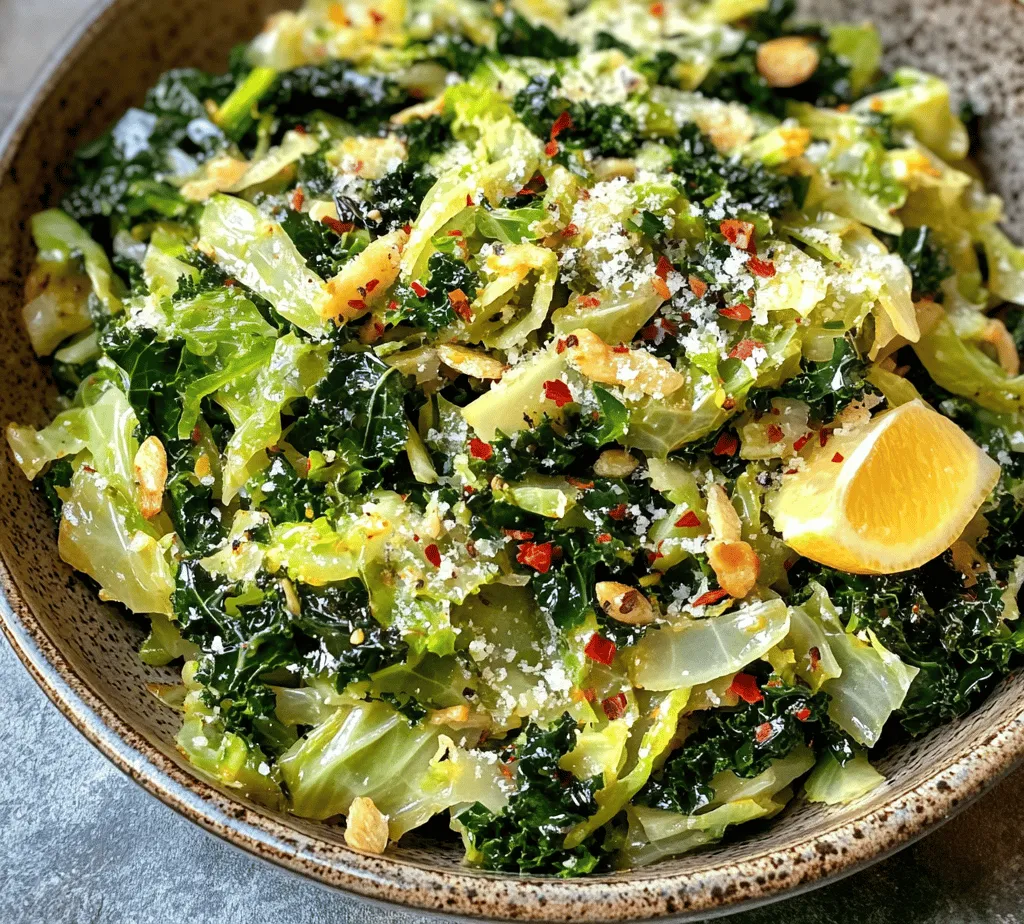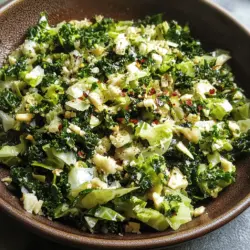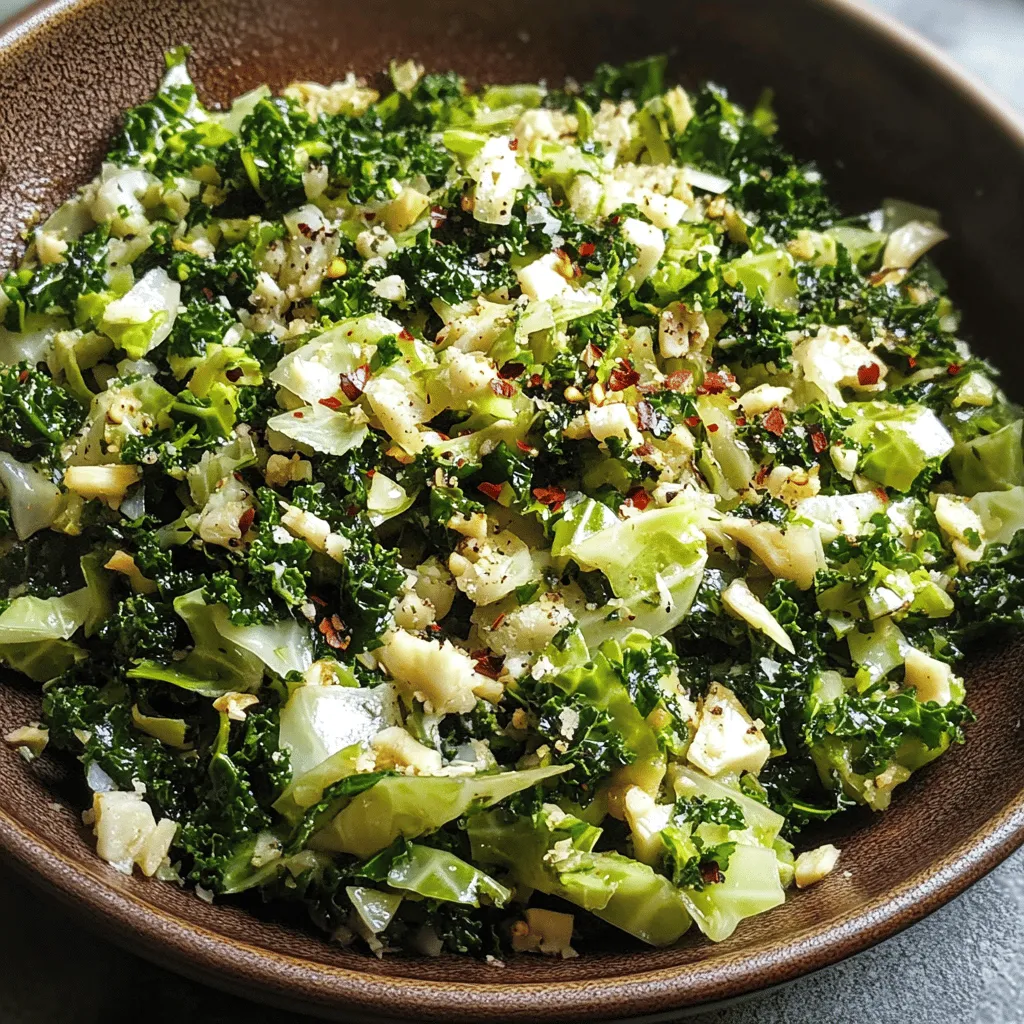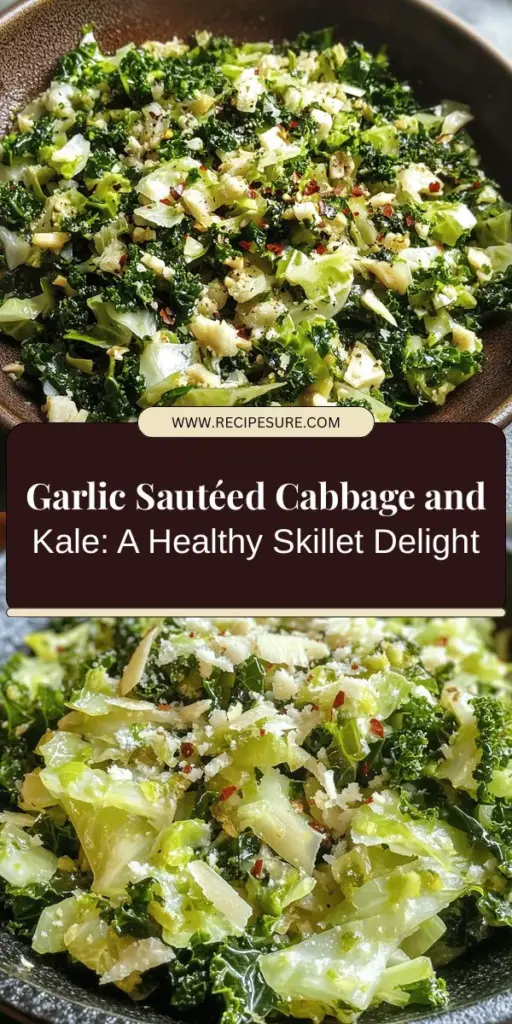Introduction
Garlic Sautéed Cabbage & Kale Skillet is a wonderfully satisfying dish that brings together the robust flavors of two nutrient-dense greens, making it a fantastic addition to any meal. With its vibrant colors and enticing aroma, this skillet dish is not only visually appealing but also packed with essential vitamins and minerals. As more people seek to incorporate healthier options into their diets, this recipe stands out as a simple yet delicious way to enjoy leafy greens.
Incorporating greens into your meals is vital for maintaining a balanced diet. Leafy vegetables like cabbage and kale are low in calories but high in fiber, making them perfect for anyone looking to boost their vegetable intake without adding unnecessary calories. Both greens are versatile, allowing them to complement a variety of main dishes or serve as a delightful stand-alone side. Plus, with the added flavor of garlic, this dish not only enhances your meals but also offers a multitude of health benefits.
The simplicity of this Garlic Sautéed Cabbage & Kale Skillet makes it an ideal choice for both busy weeknights and leisurely weekend dinners. With just a handful of ingredients and minimal cooking time, you can create a dish that’s not only healthy but also bursting with flavor. Whether served alongside grilled chicken, fish, or as part of a vegetarian feast, this recipe is sure to please.
Understanding the Ingredients
Overview of the Main Ingredients
To prepare Garlic Sautéed Cabbage & Kale Skillet, you will need fresh green cabbage, kale, garlic, olive oil, butter, and a few optional ingredients for added depth of flavor. The beauty of this dish lies in its simplicity, yet it allows for creativity with various add-ins.
Nutritional Benefits of Green Cabbage
Green cabbage is a powerhouse of nutrients. It’s particularly rich in vitamin K, which is essential for bone health and plays a crucial role in blood clotting. Additionally, cabbage is high in vitamin C, an antioxidant that supports the immune system and promotes healthy skin. This cruciferous vegetable is also a good source of dietary fiber, aiding digestion and promoting a feeling of fullness. With its low calorie count, cabbage makes an excellent choice for those looking to maintain a healthy weight.
Health Advantages of Kale
Kale, often hailed as a superfood, boasts an impressive nutritional profile. It is loaded with vitamins A, C, and K, as well as minerals like manganese and calcium. Kale is also an excellent source of antioxidants, which help combat oxidative stress in the body. Its high fiber content contributes to digestive health, while its anti-inflammatory properties can support overall wellness. Including kale in your diet can promote heart health, improve cholesterol levels, and even support brain health due to its rich concentration of nutrients.
Role of Garlic in Cooking and Health
Garlic is more than just a flavor enhancer; it also offers numerous health benefits. It contains compounds like allicin, which have been associated with various health benefits, including improved heart health and enhanced immune function. Garlic can also add a savory depth to dishes, making it a staple in many cuisines around the world. When sautéed, garlic releases its essential oils, providing a rich aroma and flavor that elevates the overall dish.
The Significance of Using Fresh Ingredients
Using fresh ingredients is key to achieving the best flavor and nutritional value in this dish. Fresh greens not only taste better but also retain more of their vitamins and minerals. When purchasing cabbage and kale, look for vibrant, crisp leaves without any signs of wilting or discoloration. Fresh garlic should be firm and free from any mold or soft spots. By prioritizing freshness, you’ll enhance the overall quality of your Garlic Sautéed Cabbage & Kale Skillet.
Optional Ingredients for Enhanced Flavor
While the core ingredients provide a fantastic base, there are several optional ingredients that can take this dish to the next level. For instance, adding a splash of vegetable or chicken broth can infuse the greens with additional moisture and flavor. You might also consider stirring in some grated Parmesan cheese or crumbled feta cheese for a creamy touch that complements the sautéed greens beautifully. For a bit of heat, red pepper flakes can be sprinkled in according to your spice preference.
Olive Oil and Butter: Health Implications and Flavor Balance
The combination of olive oil and butter is a hallmark of this recipe, offering the best of both worlds. Olive oil is known for its heart-healthy monounsaturated fats and antioxidant properties, making it an excellent choice for cooking. On the other hand, butter adds richness and a comforting flavor that can elevate any dish. When used together, they create a balanced fat profile that enhances the taste and mouthfeel of the sautéed greens.
Red Pepper Flakes: Spice Level Customization
Red pepper flakes are a fantastic way to customize the heat level of your Garlic Sautéed Cabbage & Kale Skillet. If you enjoy a bit of spice, feel free to add more flakes to suit your palate. Conversely, if you prefer a milder flavor, you can omit them entirely. This flexibility makes the dish accessible to a wide range of taste preferences, ensuring that everyone can enjoy it.
Broth and Cheese: How They Deepen Flavor and Texture
Incorporating a splash of broth not only adds moisture but also infuses the dish with additional flavor, creating a more complex profile. The cheese can provide a creamy texture that contrasts beautifully with the sautéed greens, making every bite delightful. This combination of elements allows for a richer and more satisfying dish.
Preparation Steps Explained
Now that we’ve covered the essential ingredients, let’s dive into the preparation steps for Garlic Sautéed Cabbage & Kale Skillet. Proper preparation is key to achieving the best flavor and texture in your dish.
Detailed Instructions for Prepping Vegetables
1. Washing the Greens: Start by thoroughly washing the cabbage and kale under cold running water. This step is crucial to remove any dirt or pesticides that may be lingering on the leaves. For kale, it’s especially important to ensure that all the crevices are clean, as dirt can hide between the leaves.
2. Slicing the Cabbage: Once washed, remove the core from the cabbage. You can do this by cutting the cabbage into quarters and slicing out the tough core. Then, thinly slice the cabbage into strips, roughly 1/4 inch thick. The size of the slices will influence the cooking time; thinner slices will cook more quickly.
3. Chopping the Kale: For the kale, remove the tough stems by holding the base of the stem with one hand and pulling the leaves off with the other. Discard the stems and roughly chop the kale leaves into bite-sized pieces. This will help the kale cook evenly and make it easier to eat.
4. Mincing the Garlic: Finally, peel and mince the garlic cloves. The finer the garlic is chopped, the more intense the flavor will be. For a milder taste, you can slice the garlic instead of mincing it.
Importance of Washing and Slicing Techniques
Proper washing and slicing techniques are essential for both hygiene and cooking efficiency. By removing dirt and contaminants from the greens, you ensure a safe-to-eat dish. Additionally, uniformly slicing the vegetables helps them cook evenly, preventing some pieces from becoming overcooked while others remain undercooked. This attention to detail in preparation sets the stage for a delicious final product.
Recommendations for Knife Skills for Even Cooking
Having good knife skills can significantly enhance your cooking experience. When slicing cabbage and kale, use a sharp knife for clean cuts that won’t bruise the leaves. Holding the knife at a slight angle can also help create thin, even slices. Practice makes perfect—so don’t hesitate to refine your skills with each new recipe you try.
Heating the Skillet: Tips for Achieving the Right Temperature
Once your vegetables are prepared, it’s time to heat the skillet. Begin by placing a large skillet over medium heat. Allow it to preheat for a few minutes; a properly heated skillet will help achieve a nice sauté without steaming the vegetables. To test if the skillet is ready, you can add a drop of water—if it sizzles and evaporates quickly, the skillet is at the right temperature.
Understanding the Importance of Oil and Butter Combination
As the skillet heats, add a combination of olive oil and butter. The olive oil raises the smoke point, allowing you to cook at a higher temperature without burning, while the butter adds a rich flavor to the dish. Use about two tablespoons of olive oil and one tablespoon of butter for the perfect balance. This combination will also create a luscious base for sautéing the garlic and greens.
Sautéing Garlic: Best Practices for Flavor Extraction
When the oil and butter are hot, it’s time to add the minced garlic. Sauté the garlic for about 30 seconds, stirring constantly to prevent it from burning. Garlic can quickly turn bitter if overcooked, so be vigilant. The aim is to extract the garlic’s flavor while achieving a light golden color. Once the garlic is fragrant, you can proceed to add the sliced cabbage and kale, allowing them to absorb the wonderful garlicky essence as they cook.
By following these detailed preparation steps, you will create a flavorful and nutritious Garlic Sautéed Cabbage & Kale Skillet that is sure to impress. This dish is not just a side; it’s a celebration of fresh, vibrant ingredients that nourish the body and tantalize the taste buds. Stay tuned for the next part, where we will delve deeper into the cooking process and additional tips to elevate your dish.

The Science Behind Garlic Cooking Times and Avoiding Bitterness
Cooking garlic requires a delicate balance to maximize its flavor without crossing into bitterness. When sautéing garlic, it’s essential to understand that it can become bitter if cooked too long or at too high a temperature. Garlic is composed mainly of water, and its cell structure breaks down under heat. The natural sugars in garlic caramelize, creating a rich flavor, but excessive cooking can lead to the formation of acrid compounds.
To avoid this, it’s best to add garlic to your skillet once the onions or other aromatics are already softened and cooked through. This technique ensures that the garlic infuses its flavor into the oil without burning. A general rule of thumb is to sauté garlic for no longer than 30 seconds to 1 minute until it becomes fragrant. This allows you to enjoy its sweet, mellow notes while steering clear of any bitterness.
Cooking the Cabbage and Kale
Sautéing Cabbage: Techniques for Achieving the Perfect Texture
To prepare the cabbage, begin by slicing it into thin strips. This ensures that it cooks evenly and quickly. Heat a generous amount of olive oil in a skillet over medium heat. Once the oil shimmers, add the cabbage in batches, if necessary, to avoid overcrowding the pan. Overcrowding can cause the cabbage to steam rather than sauté, compromising its texture.
As you sauté the cabbage, stir occasionally to promote even cooking. You’re aiming for a tender yet slightly crispy texture that retains a bit of bite. This typically takes about 5-7 minutes. If you like your cabbage more caramelized, you can continue cooking it for a few more minutes until it develops a golden-brown color.
How to Know When the Cabbage is Properly Cooked
The cabbage is ready when it has wilted and softened but still holds its shape. A good test is to taste a piece; it should be tender but not mushy. If you prefer a more robust texture, reduce the cooking time slightly. Keep in mind that the final texture will also be influenced by the addition of kale, which requires a different cooking time.
Adding Kale: Why Timing Matters in the Cooking Process
Kale is a heartier green than cabbage and requires less cooking time. Once the cabbage is cooked to your liking, it’s time to add the kale. Stir the chopped kale into the skillet and toss it with the sautéed cabbage. The residual heat from the cabbage will help to soften the kale without overcooking it.
Differences Between Cooking Times for Cabbage and Kale
As a general guideline, kale takes about 3-5 minutes to sauté, depending on how tender you want it. The goal is to maintain some of its vibrant green color while ensuring it wilts down to a tender consistency. You will know the kale is done when it has reduced significantly in volume and is tender to the bite, yet still has a slight chew.
Incorporating Spices: Adjusting Heat Levels to Personal Preference
To elevate the dish further, consider incorporating spices. A pinch of red pepper flakes can add a delightful kick, while a sprinkle of smoked paprika can introduce a depth of flavor. If you prefer a milder dish, you can stick to salt and pepper, which will enhance the natural flavors of the vegetables.
When adding spices, start small and adjust according to your taste. Remember that you can always add more, but it’s difficult to take out excess spice once it’s been added.
Discussing Flavor Profiles and the Impact of Seasoning
Seasoning is crucial in bringing out the natural flavors in both cabbage and kale. A good balance of salt will enhance the sweetness of the vegetables and help to draw out moisture, allowing them to caramelize beautifully. If you are using broth, consider low-sodium options to maintain control over the overall saltiness of your dish.
Finishing Touches and Serving Suggestions
The Role of Lemon Juice in Enhancing Flavors
Once your cabbage and kale are cooked to perfection, a splash of fresh lemon juice can work wonders. The acidity of the lemon brightens the dish, cutting through any richness and providing a refreshing contrast. Squeeze the juice from half a lemon over the sautéed greens and stir well. The zest of the lemon can also be added for an extra punch of citrus flavor.
How Acidity Changes Dish Dynamics
Acidity is a powerful tool in cooking; it can transform a dish from good to exceptional. In this recipe, the lemon juice not only enhances the flavor but also adds a vibrant visual appeal, making your dish more appetizing. If you’re looking for a different flavor profile, consider using apple cider vinegar or balsamic vinegar as alternatives to lemon juice.
Discussing Optional Broth: When and Why to Use It
If you want to add more moisture and depth to your dish, consider incorporating vegetable broth towards the end of cooking. A few tablespoons will not only help to steam the kale slightly but also infuse it with additional flavor. This is particularly useful if you’re serving the dish as a main course and want to ensure it’s hearty enough.
Serving Ideas and Variations
Garlic sautéed cabbage and kale can be served as a side dish or transformed into a main course. For a complete meal, consider pairing it with grains like quinoa, rice, or farro. The grains will absorb the flavors of the sautéed greens, creating a satisfying and balanced dish.
You can also serve the sautéed greens atop a bed of polenta or alongside roasted sweet potatoes for a comforting meal. For added protein, consider topping your dish with grilled chicken, tofu, or chickpeas.
Suggestions for Making It a Main Dish Versus a Side
To turn this recipe into a main dish, consider adding protein-rich ingredients. Adding cooked sausage or tofu will make it more filling. Alternatively, you can toss in some cooked beans for a plant-based protein source. This versatility makes garlic sautéed cabbage and kale a fantastic option for any meal.
Nutritional Information
This garlic sautéed cabbage and kale dish isn’t just delicious; it’s also packed with nutrients. A typical serving contains approximately:
- Calories: 100
- Total Fat: 7g
- Saturated Fat: 1g
- Protein: 4g
- Carbohydrates: 10g
- Fiber: 4g
- Sugars: 2g
- Vitamins: A, C, K, and several B vitamins
Health Benefits of Consuming Cabbage and Kale Regularly
Cabbage and kale are both low in calories and high in fiber, making them excellent choices for anyone looking to maintain a healthy weight. Kale is particularly known for its high vitamin K content, which is essential for bone health, while cabbage provides a good dose of vitamin C and antioxidants.
Regular consumption of these leafy greens has been linked to numerous health benefits, including improved digestion, reduced inflammation, and lower risks of chronic diseases.
Discussion on Dietary Restrictions and How to Adapt the Recipe
This recipe is naturally vegan and gluten-free, making it suitable for a wide range of dietary restrictions. If you are looking to reduce your sodium intake, opt for low-sodium broth or omit it altogether. For those who are following a low-carb diet, simply serve the sautéed greens on their own or with a protein option.
Conclusion
Garlic sautéed cabbage and kale is a delightful dish that balances flavor, nutrition, and versatility. Whether served as a side or a main course, this recipe can easily be adapted to suit various tastes and dietary needs.
Experiment with different spices, incorporate your favorite proteins, or serve it alongside a variety of grains to create a well-rounded meal. The simplicity of this dish makes it a fantastic staple for any meal plan, allowing you to enjoy a nutritious and delicious option with minimal effort.
By embracing easy, nutritious meals like this one, you can enhance your daily cooking routine and support a balanced diet. So, give this garlic sautéed cabbage and kale a try, and discover how delicious healthy eating can be.


